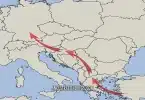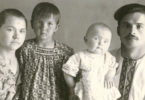Do you have a Dutch surname, or have an ancestor who had one? Then, you will want to know the origin and meaning of Dutch surnames. They can tell us much about our Dutch ancestors, their lives, their families, and even their personalities. In fact, some Dutch surnames show ancestors who had finely tuned senses of humor. If you are researching your Dutch ancestors or your own Dutch surname, here is what you need to know about the origin and meaning of these interesting names.
First of all, you need to understand Dutch surname prefixes, because many (not all, but many) Dutch surnames have them. Prefixes like Van, Ter, and Van Der are common and mean, respectively, “of,” “at,” “the,” and “of the.” When Dutch surnames are transcribed to English, these prefixes are usually attached to them without a space, so a name like De Groot becomes Degroot, and Van der Bilt becomes Vanderbilt. In Dutch genealogical databases and official records, these prefixes are ignored, as they are not considered a true part of the surname, just incidental to it. This means that if you want to find your Dutch surname in a Dutch database or official record, you need to type it without the prefix.
Another important thing to know about Dutch surnames is that people in The Netherlands did not start using them until the beginning of the 1800’s. This was far later than the early Middle Ages when most other countries in Europe started adopting surnames. Of course, some people in The Netherlands had family names before this, usually based on the village from which their family hailed, or on the profession, the male heads of the family had followed for generations. This was the exception, rather than the rule. Before surnames became official in The Netherlands, people used patronymic naming (“son of” and “daughter of”) that changed with each generation, which was the most common way of identifying people in any European nation before official surnames were adopted.
Surnames became mandatory in The Netherlands in 1811, when Napoleon Bonaparte required them. That meant everyone in the country had to choose a permanent surname for their family. It could be anything they desired, and quite a large number of families chose the patronymic surname their male head of household was already using. Others chose surnames based on their occupation, place of origin, or a description of prominent geographical features in their place of origin.
This new requirement to have surnames also gave the Dutch people a chance to show their sense of humor and a lot of them did so by choosing surnames that were deliberately meant to be funny or ridiculous. Because surnames were a new thing to the Dutch people, they expected the requirement to have them to be temporary, and the law to be lifted soon, so they didn’t take the choosing of a surname too seriously.
Also, the original use of official surnames was merely administrative, with the surname only being recorded in contacts individual people had with the government. Because of the belief that the surname requirement wouldn’t last, and because of its initial use as a purely administrative thing to identify individual people to the government, some people chose silly surnames for themselves, much like people who write in “Mickey Mouse” on presidential ballots when they go to vote.
This is how Dutch surnames like De Keyser” (meaning “the emperor”) got started. People were being silly when they chose these names and did not expect to have to use them forever, much less have them passed down through every subsequent generation of their family for centuries or more to come.
There are also incidences of Dutch surnames like “Naaktgeboren” and “Zondernaam,” which mean “born naked” and “without a name,” respectively. Clearly, the Dutch had good senses of humor.
Orphans who were found in the streets or on the steps of churches or administrative buildings were given the surname “Int’veld” (meaning, literally, “in the field”), to indicate where they were found, when those children had to be officially registered with the government.
Others chose surnames based on physical traits that had probably once been used as nicknames for them, to distinguish them from other people of the same first name in their community. Surnames like Vos (meaning “fox”) and Paard (meaning “horse”) are examples of this, as “fox” described someone’s bright red hair or wily wit, while “horse” meant someone who was strong or had badly shaped teeth.
Even with the terrific sense of humor that was used in creating some Dutch surnames, most people still chose a patronymic one when surnames began to be required. At the time of surname creation, someone using a patronymic of Pieterszoon (meaning “Peter’s son”) would often just keep that surname and make it the official one for the family, to be unchanged in the following generations, regardless of what someone’s father’s name was.
Others chose surnames based on their place of origin or a landmark at their place of origin. Names like Terpstra and Veldink (meaning “from the field” and “from the hill,” respectively) are examples of this type of naming. With geographical names, they often have endings that indicate the area of The Netherlands where a person lived. If a name ends in inga, ma, or stra, it probably originated in Friesland. If it ended in ink, ing, or inc, it originated in Overijssel, Drenthe, and Gelderland, respectively. If the rest of the surname means something to do with a house, farm, or street, you may even be able to find it on a map and discover where your first Dutch ancestor to adopt an official surname lived with some precision.
Occupational surnames were the next most common type adopted when they became a government edict. While names meaning “smith” or “baker” will be obvious, some are less clear. Surnames like Koek (meaning “cookie”) usually meant someone was a baker, and Balk (meaning “beam”) meant someone was a carpenter.






